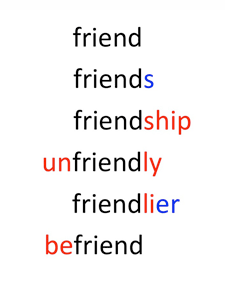About the Project
Our Research Questions
- Does morphological awareness have a different influence on reading comprehension in English and Chinese?
- Does morphological awareness play a different role in English reading comprehension for first and second language learners?
- Do morphological awareness skills account for the difference in English reading comprehension ability in first and second language learners?
What is morphological awareness?
Morphemes are the smallest units of meaning in language, and morphology is the study of them. For example, 'un' is a morpheme that when added to a base word indicates 'not', as in 'unhappy'. An awareness and understanding of morphemes is critical for understanding complex multi-morphemic English words such as 'unhappy', 'happier', 'unhappiness', and how they are related.
 Using morphemes to form words
Using morphemes to form words
What has morphological awareness got to do with reading?
Awareness of morphemes can help a beginning reader to map their spoken language onto written forms, and subsequently aid word recognition. The ability to consider a word as a sum of its parts also allows a reader to approach an unfamiliar word within a text and attempt to determine its meaning. In this way, morphological awareness helps us to acquire new words into our vocabulary and enables us to read more challenging texts.
This project will build on evidence that an understanding of morphemes is related to a child's reading comprehension level throughout development.
Why study morphological awareness across languages?
We aim to explore the relationship between morphological awareness and reading comprehension by comparing two groups of readers: English children learning to read English, and Hong Kong Chinese children who are learning to read both Chinese and English. We are studying these two groups of young readers because the English and Chinese writing systems place a different emphasis on morphemes.
The English writing system represents the spoken sounds of the language, so that beginning readers in English have to sound out the letters of unfamiliar words. This allows them to access words they already know in their written forms.
In contrast, the Chinese writing system represents the morphemes – directly corresponding to the meanings of words. This means that beginner readers of Chinese cannot 'sound out' words, as there are few clues to the pronunciation of Chinese words. Because the writing system represents the morphemes, there are clues to each word's meaning even if the actual word has not been seen before in its printed form. For example, the Chinese character for sun also appears in the written forms of other related words - such as warm, evening, and shine.
We seek to compare the influence of morphological awareness on reading comprehension in each language.
Why study morphological awareness across age?
The different writing systems of the two languages in our study, English and Chinese, may have different implications for the relationship between morphological awareness and reading comprehension across development. Readers of Chinese may be attuned to morphological awareness earlier in development than readers of English, because learning to read in Chinese focuses attention on word structure and meaning from the very earliest stages of reading development.
We seek to compare the influence of morphological awareness on reading comprehension from 7 to 13 years of age in each language.
Funded by
Economic and Social Research Council
Research Grants Council (Hong Kong)
UK Research team:
- Principal Investigator
- Professor Kate Cain
- Research Associate
- Emma James
HK Research team
- Principle Investigator
- Professor Xiuli Tong
- Research Associate
- Joyce Mok
Contact Us
If you would like to discuss this work further, please contact the Principal Investigator
